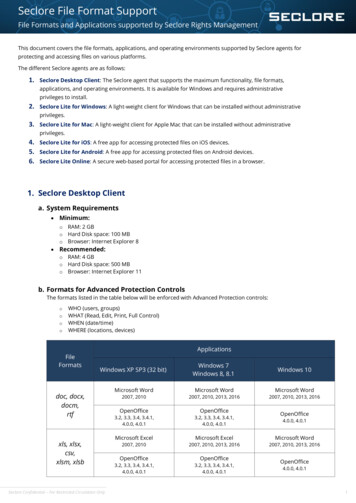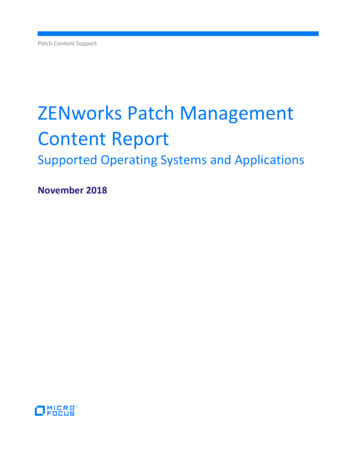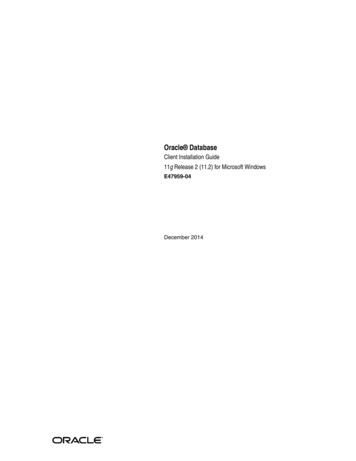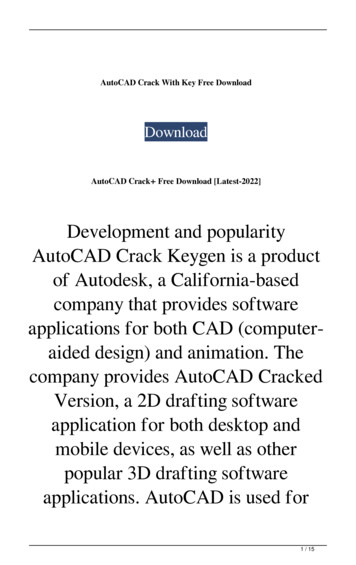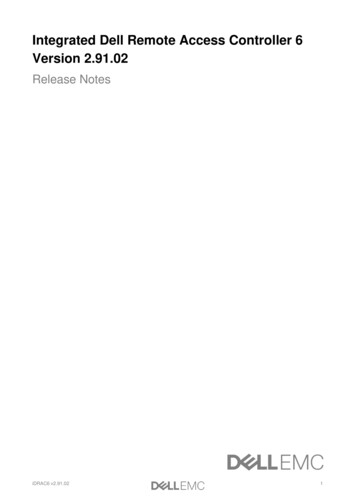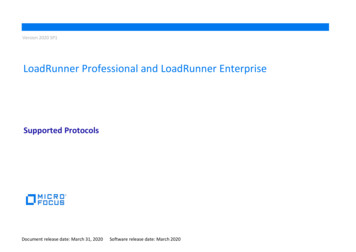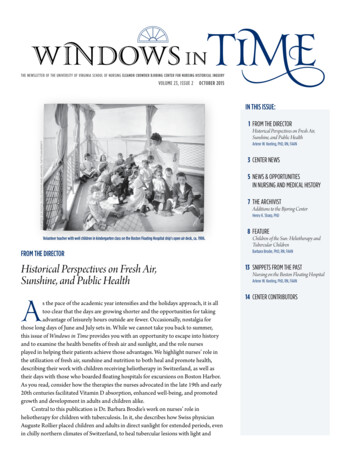
Transcription
The Newsletter of the University of Virginia School of Nursing Eleanor Crowder Bjoring Center for Nursing Historical InquiryVolume 23, Issue 2October 2015In this issue:1 From the DirectorCourtesy of Digital Collections and Archives, Tufts UniversityHistorical Perspectives on Fresh Air,Sunshine, and Public HealthArlene W. Keeling, PhD, RN, FAAN3 Center News5 News & Opportunitiesin Nursing and Medical History7 THE ARCHIVISTAdditions to the Bjoring CenterHenry K. Sharp, PhD8 FeatureVolunteer teacher with well children in kindergarten class on the Boston Floating Hospital ship's open air deck, ca. 1906.From the DirectorHistorical Perspectives on Fresh Air,Sunshine, and Public HealthAs the pace of the academic year intensifies and the holidays approach, it is alltoo clear that the days are growing shorter and the opportunities for takingadvantage of leisurely hours outside are fewer. Occasionally, nostalgia forthose long days of June and July sets in. While we cannot take you back to summer,this issue of Windows in Time provides you with an opportunity to escape into historyand to examine the health benefits of fresh air and sunlight, and the role nursesplayed in helping their patients achieve those advantages. We highlight nurses’ role inthe utilization of fresh air, sunshine and nutrition to both heal and promote health,describing their work with children receiving heliotherapy in Switzerland, as well astheir days with those who boarded floating hospitals for excursions on Boston Harbor.As you read, consider how the therapies the nurses advocated in the late 19th and early20th centuries facilitated Vitamin D absorption, enhanced well-being, and promotedgrowth and development in adults and children alike.Central to this publication is Dr. Barbara Brodie’s work on nurses’ role inheliotherapy for children with tuberculosis. In it, she describes how Swiss physicianAuguste Rollier placed children and adults in direct sunlight for extended periods, evenin chilly northern climates of Switzerland, to heal tubercular lesions with light andChildren of the Sun: Heliotherapy andTubercular ChildrenBarbara Brodie, PhD, RN, FAAN13 Snippets from the PastNursing on the Boston Floating HospitalArlene W. Keeling, PhD, RN, FAAN14 Center Contributors
Eleanor Crowder Bjoring Center forNursing Historical InquiryStaffArlene Keeling, PhD, RN, FAAN, Directorawk2z@virginia.eduBarbara Brodie, PhD, RN, FAAN, Associate Directorbb9w@virginia.eduMary E. Gibson, PhD, RN, Assistant Directormeg2e@virginia.eduJohn C. Kirchgessner, PhD, RN, PNP, Assistant Directorjkirchgessner@sjfc.eduLinda Hanson, MSM, Project Coordinatorllh3x@virginia.eduCenter AssociatesW. Bernard Carlson, PhDwc4p@virginia.eduRebekah Carmel, PhD, CRNArlc2p@virginia.eduAnne Z. Cockerham, PhD, RN, CNM, WHNPAnne.Cockerham@frontierschool.eduSarah J. Craig, PhD, RN, CCNS, CCRNsjw5y@virginia.eduDeborah L. Gleason, PhD, APRN, CPNPdlg7b@virginia.eduBarbara L. Maling, PhD, APRN, ACNP-BCbarb.l.maling@gmail.comJessica Malpass, PhD, RNjlk2t@virginia.eduNena Powell, PhD, RNpowellnj@jmu.eduJennifer Casavant Telford, PhD, ACNP-BCjennifer.telford@uconn.eduLisa Zerull PhD, RN, FCNlzerull@valleyhealthlink.comCenter AffiliatePamela B. DeGuzman, PhD, MBA, RNdeguzman@virginia.eduEditorial StaffJohn C. Kirchgessner, EditorLinda Hanson, Assistant EditorRoseberries, DesignBrodie Fellows2015–2017 Jaime Lapeyre, PhD, RN2014–2016 Jonathan Hagood, PhDCenter VolunteersLinda DaviesCarolyn J. DuValRobert DuValJoAnne Hutchinson PeachWindows in Time can be found on EBSCOhost andGale Group, Inc. databases.Contact InformationCenter Phone (434) 924-0083Center email nurs-hxc@virginia.eduCenter website nursing.virginia.edu/cnhi 2015 by the Rector and Visitors of the University of Virginia 2Windows in TimeVitamin D. It is a fascinating article, describing the therapeutic protocol that Rollieradvocated and emphasizing the nurses’ physical and emotional care of children isolatedfrom their parents during long courses of treatment. I hope you enjoy it!Another feature emphasizing the use of fresh air and sunshine, as well as healtheducation for mothers of sick children, is the “Snippets” feature on the Boston FloatingHospital. Once a rented excursion boat used to take mothers and sick babies for a day’souting on Boston Harbor, the Floating Hospital is now a permanent building withinTufts New England Medical Center. While some has been documented about thehospital ship itself, little has been written about the nurses’ role on the barge as theysailed out to harbor to escape the steamy summers of East Boston. The short article onpage 13 is an attempt to fill that gap in our history.As you will note on page 5, in addition to Barbara Brodie’s talk on heliotherapyin September, other history forums this fall include a presentation by Brodie FellowJaime’ Lapeyere on solutions to the problem of finding public health nurses afterWorld War I, and a panel on the history of school nursing in Virginia. The latter, ledby Dr. Mary Gibson and including a paper written by PhD student Bridget Houlahan,culminates with a discussion of Dr. Doris Glick’s development of a nurse-run schoolhealth clinic in Greene County in the 1990s. After that forum we invite you to join usin a reception for Doris Glick as we formally receive her collection.In concert with the theme of historical perspectives on nurses’ role in healthpromotion, I’d like to draw your attention to the Center’s window display this fall. Setin New York City at the turn of the century, the window highlights a nurse teaching ayoung immigrant mother how to save her infant from the deadly “summer diarrhea.”First and foremost advocating breast-feeding, but also teaching mothers who couldnot breast-feed to keep milk on ice between feedings and to wash and sterilize bottles,nurses played a key role in promoting infant welfare. I hope you will get a chance tosee it!This editorial is the last I will write as Director of the Bjoring Center. My tenureas Director has been a joyful and exciting experience, but I am ready to step downand assume a supporting role as Associate Director. I am turning over the Center’sleadership to my close friend and colleague, Barbra Mann Wall, PhD, RN, FAAN, whowill begin serving as Director in December of this year. On page 3, Barbara Brodieintroduces Dr. Wall and expresses our faith in her ability to lead the Bjoring Center toa new level of scholarship and productivity. I hope you will wish Barb a warm welcomewhen you see her!All my best,Arlene W. KeelingThe Eleanor Crowder Bjoring Center for Nursing Historical Inquiry(ECBCNHI), established at the University of Virginia in 1991 to supporthistorical scholarship in nursing, is dedicated to the preservation and studyof nursing history. The development of advanced clinical nursing practice,and the clinical specialty organizations that represent the various practices,is a major focus of the Center. The goals of the Center include the collection of materials, the promotion ofscholarship, and the dissemination of historical research findings.university of Virginia school of nursingwww.nursing.virginia.edu/cnhi
CeNteR NeWsBarbra Mann WallIt is with great pleasure that we introduce Barbra Mann Wallto the Eleanor Crowder Bjoring Center for NursingHistorical Inquiry. Barbra has been appointed to the UVASchool of Nursing faculty as the Thomas A. Saunders IIIProfessor of Nursing. In December 2015 she succeeds ArleneKeeling to become the third director of the Center for NursingHistorical Inquiry; Arlene will become the Center’s AssociateDirector. Barbra comes to us from the University of PennsylvaniaSchool of Nursing where she was an Associate Professor andthe Acting Director of the Barbara Bates Center for the Study ofNursing History.Dr. Wall holds a bachelor’s in nursing degree from theUniversity of Texas at Austin, a masters of science degree fromTexas Woman’s University, and a PhD in history from theUniversity of Notre Dame.A creative researcher and productive scholar, Barbra is theauthor of three noted books and numerous articles and bookchapters. Her award winning first book, Unlikely Entrepreneurs:Catholic Sisters and the Hospital Marketplace, 1865–1925,explored the major role that private and public hospitals playedin helping the nation meet the health needs of its diverse andexpanding population.In two of her more recent books, American CatholicHospitals: A Century of Changing Markets and Missions and IntoAfrica: A Transnational History of Catholic Missions and SocialChange, Barbra continued her exploration of the nurse‘s role increating needed medical facilities and new health policies thatenriched the lives of citizens. She has also co-authored withArlene Keeling two books on the role of nurses in disaster, andthey are currently exploring new joint publication endeavors.In addition to Barbra’s impressive intellectual talents as oneof the nation’s leading nursing history scholars and educators,she brings a charming and gracious personality to the Center.We, the faculty and staff of the Center for NursingHistorical Inquiry, are delighted to welcome Barbra to theUniversity, the School of Nursing and to the Center! We lookforward to working closely with her as we continue to fulfillthe center’s mission as a premier international nursing historyresearch facility. n —Arlene Keeling, John Kirchgessner, Mary Gibson,Barbara Brodie, and Linda HansonCongratulationsCenter Associate Anne Z. Cockerham,PhD, CNM, WHNP-BC, CNE, was namedAssociate Dean for Academic Affairsat Frontier Nursing University and wasselected for the American Association ofColleges of Nursing (AACN) Leadershipin Academic Nursing Program (LANP).On June 1, 2015 Rebekah L. Carmelsuccessfully defended her dissertation“Over the Drape: Olive Berger and‘blue baby’ anesthesia, 1944–1954”.Dr. Carmel’s dissertation examined thework of Olive Berger and the impact oftechnology on nurse anesthetists’ practicein the 1940s. Berger, who was a nurseanesthetist at Johns Hopkins hospital for30 years, documented the care given to“blue babies” after they underwent theBlalock procedure, an unprecedentedtechnique for performing infant heartsurgery pioneered by Dr. Alfred Blalock.Congratulations, Dr. Carmel!Rebecca Coffin, PhD candidate, wasawarded the 2015 Barbara Brodie ScholarAward. The award, established by a groupof nursing alumnae, supports doctoralnursing students’ research. nWindows in Time Eleanor Crowder Bjoring center for nursing historical inquiryOctober 20153
CenteR NeWsCenter ProductivityPresentationsGibson, M. “Nuts and Bolts of PlanningSell, L. B. “Power of Partnerships: Howand Displaying Archival Resources on thePublic Health Nurses Partnered toWeb” (paper presented at the SouthernImprove Access to Care for Blacks in theAssociation for the History of MedicineSouth in the 1930s” (paper presented atand Science Conference, Jackson,the Southern Association for the HistoryMississippi, March 14, 2015).of Medicine and Science Conference,Jackson, Mississippi, March 13, 2015).Hehman, M. “‘When Do the LittleDears Give Their Next Performance?’:Ethics and Nursing Care in the InfantPublicationsUVA presenters at the Southern Association for the History of Medicineand Science Conference, March 2015.Kirchgessner, J., A. Keeling and M.Gibson. “Nurses in schools, coal townsIncubator Exhibit at Chicago’s Century ofProgress Exposition (1933–1934)” (paperBrodie, B. “‘Hurting and caring’: Nursingand migrant camps: Bringing healthcarepresented at the Southern Associationburned children in the Chicago Schoolto rural America, 1900–50.” In Historiesfor the History of Medicine and Sciencefire disaster, 1958.” In Histories of Nursingof Nursing Practice, edited by G. Fealy,Conference, Jackson, Mississippi,Practice, edited by G. Fealy, C. HallettC. Hallett and S. Malchau Dietz, 180–199.March 13, 2015).and S. Malchau Dietz, 69–81. Manchester,Manchester, UK: Manchester UniversityUK: Manchester University Press, 2015.Press, 2015.and the Great Depression, 1935–1941”Schminkey, D. L. & A. Keeling.Maling, B. “The Bar Harbor Fire of 1947,(paper presented at the Southern(2015). “Frontier nurse-midwives andBar Harbor, Maine (USA).” In Nurses andAssociation for the History of Medicineantepartum emergencies, 1925 to 1939.”Disasters: Global, Historical Case Studies,and Science Conference, Jackson,Journal of Midwifery and Women’s Healthedited by A. Keeling & B. Wall, 201–227.Mississippi, March 13, 2015).60, no. 1 (2015): 48–55.New York, NY: Springer PublishingMilbrath, R. “‘Monica, the Whole WorldKeeling, A. and B. Wall, eds. Nurses andKnows We’re at War’: The Nurses of PearlDisasters: Global, Historical Case Studies.Milbrath, R. “The Bombing of PearlHarbor, Hickam Field Hospital” (paperNew York, NY: Springer PublishingHarbor, Hawaii, December 7, 1941.” Inpresented at the Southern AssociationCompany, 2015.Nurses and Disasters: Global, HistoricalKeeling, A. “Nurses, Migrant Workers,Company, 2015.for the History of Medicine and ScienceCase Studies, edited by A. Keeling & B.Conference, Jackson, Mississippi,Wall, 145–167. New York, NY: SpringerMarch 14, 2015).Publishing Company, 2015. nTransition reception to thankArlene Keelingfor her leadership of theEleanor Crowder Bjoring Center for Nursing Historical Inquiryand to welcomeBarbra Mann Wallas the Center’s new Director.December 1, 20155–6:30 PMMcLeod Hall lobby and Bjoring CenterAll are invited! 4Windows in Timeuniversity of Virginia school of nursingwww.nursing.virginia.edu/cnhi
News & OpportunitieSin Nursing and Medical History2015/2016Nursing HistoryForumsMcLeod Hall #5060Noon–1 p.m.September 29, 2015Children of the Sun: Heliotherapyand Tubercular ChildrenBarbara Brodie, PhD, RN, FAANThe Third Agnes Dillon Randolph InternationalNursing History Conference at the University ofVirginia, Charlottesville, VirginiaMarch 11–12, 2016In recognition of the diversity and quality of nursing scholarship across theworld, the University of Virginia School of Nursing Eleanor Crowder BjoringCenter for Nursing Historical Inquiry is hosting the Third Agnes Dillon RandolphInternational Nursing History Conference. The conference will be held at theUniversity of Virginia School of Nursing.The keynote address, “MaryBreckinridge, Steady in the Saddle:Leadership and the Frontier NursingService,” will be presented by Anne Z.Cockerham, PhD, CNM, WHNP-BC,CNE, Frontier Nursing UniversityAssociate Dean for Academic Affairs,Bjoring Center Associate and RandolphAward recipient.Further information is available onthe conference website: h-conference/ nOctober 20, 2015‘Generalised nursing’: the solutionto the difficulty of Public Healthwork?Jaime Lapeyre, PhD, RNLecturer, University of Toronto2015 Brodie FellowNovember 11, 2015The Evolution of School NursingPanel PresentationFebruary 16, 2016“A Room with a View: Using Naturein the Treatment of the Mentally Ill.St. Elizabeths Hospital, 1852–1900”Beth Hundt, MS, APRN, NP-C,ACNS-BC, CCRN-CSC,UVA PhD StudentAnne Z. CockerhamWindows in Time Eleanor Crowder Bjoring center for nursing historical inquiryOctober 20155
News & OpportunitieSConferencesCall for ApplicationsAmerican Association of the History of MedicineMinneapolis, MinnesotaApril 28–May 1, 2016Additional information: www.histmed.orgThe American Association for the History of Nursing(AAHN) offers four awards for completed research, eachpresented annually at the Fall Nursing History Conference.Only AAHN members are eligible to apply for these awards.Deadline for award submissions is May 15 of each year.Cultures of Harm in Institutions of Care:Historical & Contemporary PerspectivesApril 15–16, 2016Birkbeck, University of London, EnglandAdditional information:www.bbk.ac.uk/trauma/events/Teresa E. Christy Award— to encourage new nursinghistory investigators, and to recognize excellence ofhistorical research and writing done while the researcherwas in a student status.Lavinia L. Dock Award— to recognize outstandingresearch and writing produced by an experienced scholar innursing history who submits a bookThe Southern Association for the Historyof Medicine and ScienceLas Vegas, NevadaMarch 17–19, 2016Additional information: www.sahms.netVictorian Studies Association of Western Canada2015 Conference“Victorian Intimacies”April 22–23, 2016Winnipeg, Manitoba, CanadaAdditional 16-conference/Mary Adelaide Nutting Award—to recognize outstandingresearch and writing produced by an experienced scholarin nursing history who submits, most often, a post-doctoralresearch manuscript or article.Mary M. Roberts Award—to recognize outstandingoriginal research and writing in an edited book of nursinghistory.Additional information: www.aahn.org/awards.htmlCalls for AbstractsAmerican Association for theHistory of NursingSeptember 22–25, 2016Chicago, IllinoisAbstracts due January 31, 2016Additional information: www.aahn.org 6Windows in TimeAmerican Holistic NursesAssociationMay 31–June 5, 2016Bonita Springs, FloridaAbstracts due October 15, 2015Additional posalsuniversity of Virginia school of nursingCanadian Association for theHistory of Nursing“Brains, Guts and Gumption:Historical Perspectives onNursing Education, Practice andEntrepreneurship”June 16–18, 2016Vancouver, CanadaAbstracts due January 31, 2016Additional sing.virginia.edu/cnhi
The ArchivistAdditions to the Bjoring CenterAHenry K. Sharp, PhDECBCNHI Doris Glick CollectionTwo additional dofacility for the elderly andnations made to thedisabled, both near downBjoring Center this yeartown Charlottesville. Soonoffer similar insights fromafterward, Glick successearlier in the twentiethfully negotiated with thecentury. Nancy Milio hasGreene County Publicgiven more documentationSchool System to create theto supplement her fasci“Health Cottage,” a facilnating collection openedity offering healthcare forto researchers in 2011.school-aged children from Public Health pamphlet, 1936.Readers may recall that Dr.a largely rural environmentMilio served as the organizing catalyst fornorth of Charlottesville. Patient cohortsthe Moms and Tots Center, a communifor the three clinics thus crossed thety-based and staffed clinic and day-careboundaries of race, gender, age, ability,center in inner-city Detroit—a facilityand urban/rural contexts.spared destruction in the city’s devastatDr. Glick’s nursing clinic initiativeing 1967 riots, precisely because of theconfronted the healthcare availability issueestablished community involvement inacross these underserved populations withmanagement and organization of thean organizational framework that broughtCenter and its services.nursing care out of distant, centralized faThe other donation supplies addicilities to the patients themselves in theirtional information about the activitieslocal environment, and—of equal imporand education of Caroline H. Benoisttance—to populations who tended to use(1896–2000), a public health nurse whosehospital emergency facilities for primarycareer spanned the teens to the 1940s.care, if they sought care at all. NursingMs. Benoist studied and worked initiallystudents worked with clinical instructorsin Chicago and Nashville, but spent theand staff, gaining significant real-worldgreat majority of her career in Sunflowerexperience. In a word, the program wasand Pike Counties, Mississippi, where shedirect, even simple in conception, butwas one of the first public health nurseswith quite sophisticated andin the state. She trained and supervisedcomprehensive implicationsteams of African-American midwives andfor the structure, manageserved on the healthcare frontline for thement, and cost of Americanrural laborers and farm workers of thehealthcare. The clinics continDelta, not too many generations removedued in operation until 2000,from antebellum life and conditions.and the lessons still have curThe profession of Nursing has arency for our healthcare crisiscritical role to play in expanding accessdeliberations.to primary care. These collections demonstrate just how significant that role hasUVA School of Nursing students at theWesthaven Clinic.been to our nation’s public health. nWindows in Time Eleanor Crowder Bjoring center for nursing historical inquiryECBCNHI Caroline Benoist Collectionccess to healthcare—compassionate, efficient, high-qualityhealthcare—is a critical component of America’s ongoing public healthpolicy debate. The issue is not a new one,of course, and three recently accessionedor expanded collections here at the Bjoring Center highlight different approachesto the topic across the twentieth century.In November, the Center will hosta reception ceremony for an importantmanuscript donation concerning a rangeof topics related to access to healthcare.The collection comes to us from UVAnursing professor, emerita, Doris F. Glick.When she joined the Virginia facultyin1989, Dr. Glick set about designing anursing clinic program to provide primary care and referrals to three distinct,traditionally underserved populationsin Charlottesville and vicinity. The U.S.Department of Health and HumanServices awarded Dr. Glick a five-yearPublic Health Services grant in 1993,and along with significant contributionsfrom other sources, Glick establishedPrimary Care Nursing Clinics at theWesthaven general public housing complex and at Crescent Halls, a residentialOctober 20157
Children of theHeliotherapy and Tubercular Children 8Windows in Timeuniversity of Virginia school of nursingwww.nursing.virginia.edu/cnhi
SunBy Barbara Brodie, PhD, RN, FAANAssociate Director Eleanor Crowder Bjoring Center for Nursing Historical Postcard, c. 1925. Courtesy of Casas-Rodríguez Collection.he importance of the sun to humans has been recognized forthousands of years. Its ability to provide sunlight, warmth, and asense of well-being coupled with its power to grow food allowedcivilization to flourish.Evidence exists that in ancient Egypt, Greece, India, and Rome earlyhealers recognized the sun’s tremendous power and attempted to harnessit to cure diseases.1 However, it would be in the late 1890s before themedical profession seriously investigated whether the sun’s rays possessedan ability to heal. The pioneer physicians who studied this questionwould develop a new medical treatment modality known as light therapy,which included heliotherapy (sun light) and phototherapy (artificiallight-ultra light). This therapy had proved effective in treating severalforms of tuberculosis, a lethal disease that had plagued humankindfor centuries. 2The leading advocates for light therapy were two Europeanphysicians, Danish Niels Finsen (1860–1906)3 and Swiss Auguste Rollier(1874–1954), and an American, John Harvey Kellogg (1852–1943).4They believed that heliotherapy would lead to better outcomes for thechildren who suffered from scrofula (bone and skin) tuberculosis thanwhat was currently available. Surgeons of the era routinely treated thesechildren by excising extensive portions of their infected tubercularbones, but this intervention often left the children uncured, deformed,and crippled.5Rollier and Kellogg maintained that heliotherapy, under thedirection of skilled physicians, could heal the patients’ tuberculosisand help them regain their vitality and lives. Although both Rollier andKellogg operated their own sanatoriums and used heliotherapy, Kelloggconsidered sun therapy as part of his natural therapeutic regimen ofJ. Potts, “The effects of sunlight on man,” Phi Delta Kappa 14 (1931): 29–32.S. Carter, “The Medicalization of Sunlight in the Early Twentieth Century,” Journal of Historical Sociology25 (2012): 83–105.3Niels Finsen was awarded the Nobel Prize for Medicine in 1903 for his discovery of phototherapy andartificial light therapy.4T. Woloshyn, Our Friend, the Sun: Images of Light Therapeutics from the Osler Collection, c. 1901–1944.Exhibit Booklet—January to June 2011, Osler Library of the History of Medicine. (McGill UniversityPress, 2011), 1–3.5O Bernhard, “The Need for Climatic Sanatoria for Indigent Patients Suffering from Surgical Tuberculosis,”Jersey State Medicine 39 (1931): 333–34.12Windows in Time Eleanor Crowder Bjoring center for nursing historical inquiryOctober 20159
Daily TreatmentWhen first admitted, the children required time to acclimate tothe high altitude of the mountains, the cold air, and the intensesunlight. Many of the children were underweight, fatigued,and disfigured by large open sores and lesions. Each day afterbreakfast, the children were lightly dressed and placed by age inopen porch rooms; their rolling beds were moved closer to openwindows to allow them to be exposed indirectly to the sun andcold air.9J. Kellogg, Light Therapeutics: a practical manual of phototherapy for the student and thepractitioner (Battle Creek: The Modern Medicine Pub. Co., 1927), 68–88.T. Woloshyn, “Patients rebuilt: Dr Auguste Rollier’s heliotherapeutic portraits, c. 1903–1944,” Medical Humanities (2013): 38.8A. Rollier, “Tuberculosis finds Cure in the Leysin Heliotherapy Clinics,” The ModernHospital 21 (1923): 255–260.9A. Rollier, Heliotherapy (London: Henry Frowde and Holder Stoughton Publishers, 1923),19–30.67 10Windows in TimeA. Rollier, “The Share of the Sun in the Prevention and Treatment Tuberculosis,” BritishMedical Journal 2 (1922): 741–745.R. S. Hobday, “Sunlight Therapy and Solar Architecture,” Medical History 42 (1997):455–472.12“Medicine: Heliotherapy,” Time Magazine 1 (August, 1923): 191011university of Virginia school of s.org/licenses/by-nc-nd/4.0/Courtesy of the Swiss National Museum. Image #ROH-10-LM-1147671.nutritious food, rest, and exercise.6 For Rollier heliotherapy wasa powerful therapeutic agent that acted like a bacterial surgicaldressing, and it had proven successful in the cure of nonpulmonary tuberculum patients.7In 1903, Dr. Rollier opened his first sun solaria to treattubercular children in the town of Leysin, high in the Swiss Alps,and soon it began to attract tubercular patients from Europe.Rollier insisted that every child admitted to the solaria undergoa complete physical examination, including blood and x-rayexams, and an evaluation of how well the child could adjust tothe altitude, cold air and sun therapy. From this informationthe medical staff developed individualized therapy plans thatincluded sun baths, a diet rich in fats, grains, vegetables, andmilk, plus planned exercise. The children’s exposure to thesun and their reaction to the cold air, their temperatures, andphysical activity were carefully timed and monitored. 8After several weeks or months when their wounds hadsufficiently healed and they were without fever, they were readyfor their prescribed outside sunbaths to begin. Covered witha sheet and dressed in simple linen caps, short white pantsand wearing dark glasses, the children were carefully exposedto direct sun rays. Throughout the day, the nurses, who wereprimarily responsible for implementing the physician’s orders,carefully timed the length of light exposure on each part ofthe child’s body. Beginning with their feet and slowly movingupward, the children’s skin slowly tanned, soon taking on thehighly desired copper tone appearance. With each passingweek they grew physically and emotionally stronger. Whenconsidered strong enough, the physicians ordered the childrenout of bed and sent outdoors. Here, dressed in boots, sunglasses,short pants, and hats they engaged in a wide variety of physicalexercises and play activities scheduled throughout the year.These year-round activities were possible because the averageday time temperature on the sunny mountain top was in the 70sfor much of the year.10Rollier believed that the sun’s rays held therapeutic andrevitalizing powers that could heal and restore the tubercularchildren’s bodies. His early experience in treating sick childrenconvinced him that other medical personnel needed tounderstand the power of heliotherapy, and to assure this wouldhappen he became its leading advocate.11 News of his success inhealing tubercular patientsspread across Europe andNorth America. Timemagazine carried an articleabout the new therapy in1923, the first year of itspublication. In it was notedthat Dr. Rollier and hiscolleagues had treated, overa twenty year period, 2,000children with joint andbone tuberculosis with an80 percent cure rate.12Auguste Rollier. Courtesy of the Royal Library:The National Library of Denmark and CopenhagenAware of the power ofUniversity Library.photographs to documentthe changes in the children’s state of health, Rollier employedprofessional photographers to capture images of the childrenconvalescing, playing, and exercising on the sun-drenched snowymountain slopes of his sanatoria. With a keen appreciation
Spread of HeliotherapyAlthough scientific evidence of how heliotherapy actually workedwas still lacking, physicians, who could offer little to cure theirseriously ill tubercular patients, believed that they should use iton their patients. Some physicians also used it to treat patientssuffering from rheumatic fever in hopes that it might help them.The scientific discovery of vitamins, especially vitamin D found insunlight and milk in 1923, further encouraged physicians to useT. Woloshyn, “’Kissed by the Sun’: Tanning the Skin of the Sick with Light Therapies,1890–1930,” in A Medical History of the Skin: Scratching the Surface, J. Reinarz and K. Siena(London: Pickering & Chatto, 2013), 181–194.14T. Woloshyn, “Patients rebuilt: Dr Auguste Rollier’s heliotherapeutic portraits,c. 1903–1944,” Medical Humanities (2013): 39–4213heliotherapy in the care of theirtubercular patients.The use of heliotherapy wasa challenge in geographic areaslacking long periods of sun lightand warmth. Local physician
at Frontier Nursing University and was selected for the American Association of Colleges of Nursing (AACN) Leadership in Academic Nursing Program (LANP). On June 1, 2015 Rebekah L. Carmel successfully defended her dissertation "Over the Drape: Olive Berger and 'blue baby' anesthesia, 1944-1954". Dr. Carmel's dissertation examined the

